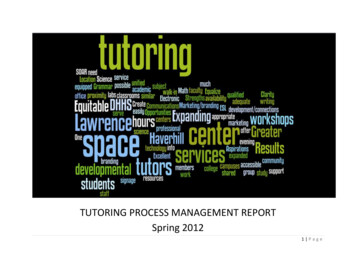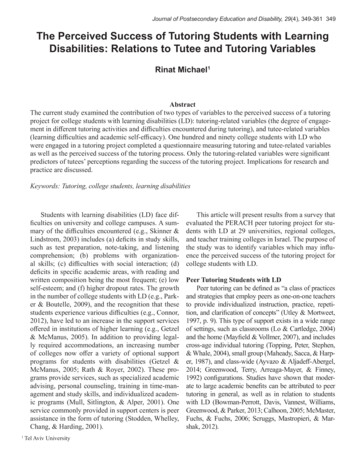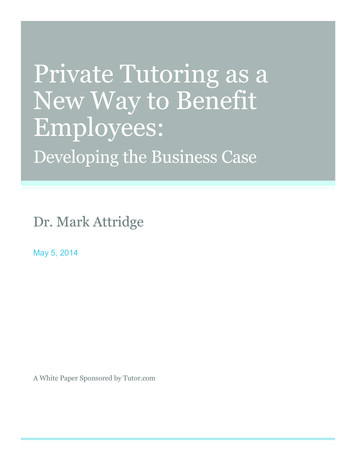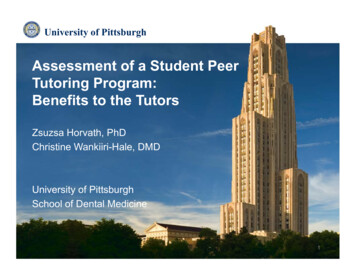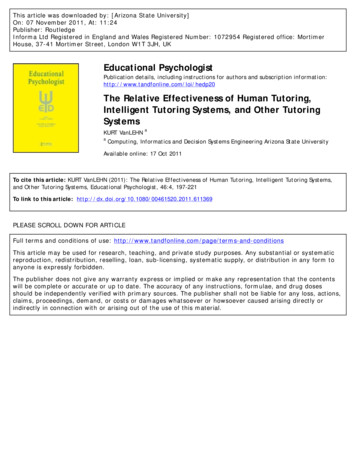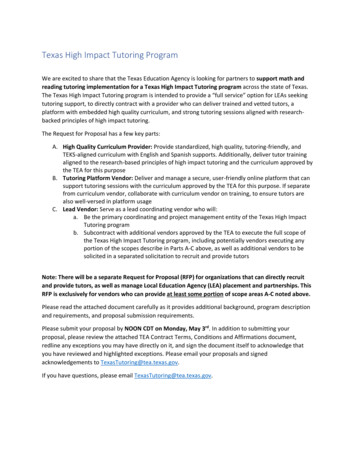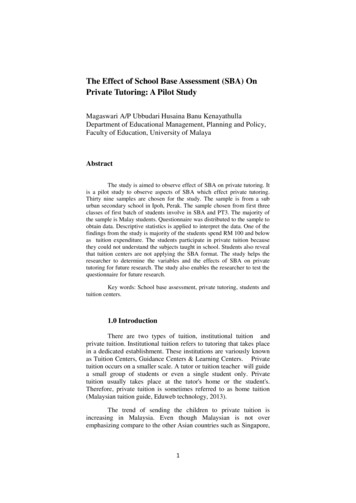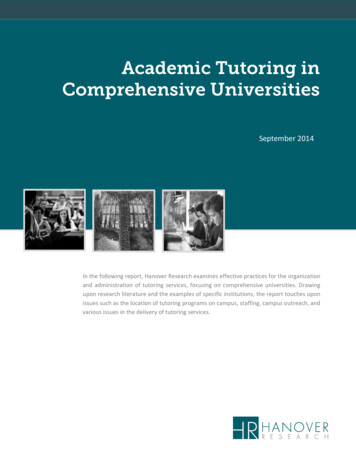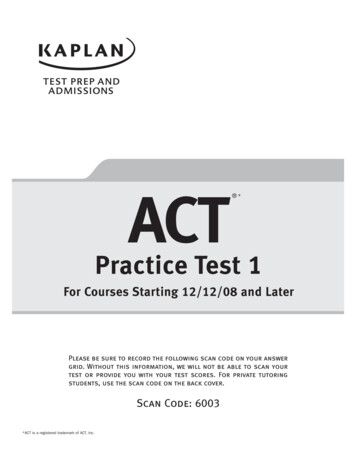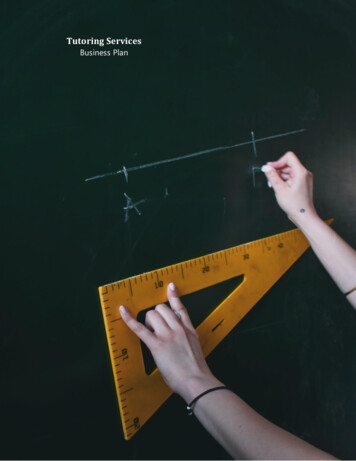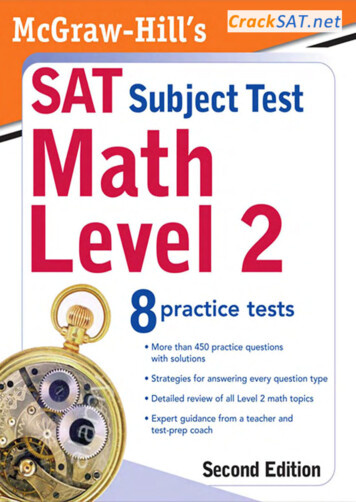
Transcription
Useful Links:SAT Online Practice Tests: http://www.cracksat.net/tests/SAT Subjects Tests: http://www.cracksat.net/sat2/SAT Downloads: http://www.cracksat.net/sat-downloads/For more SAT information, please visit http://www.cracksat.netSAT Downloads:SAT real tests -real-tests.htmlSAT official guide tests -official-guide-tests.htmlSAT online course tests -online-course-tests.htmlSAT subject tests -subject-tests.htmlPSAT real tests 0 College Admission Essay essays/
THE TOP 30 THINGS YOU NEEDTO KNOW FOR TOP SCORES INMATH LEVEL 21. FRACTIONSMake sure you know how to simplify fractions because answers are generally presented in simplest form. Be able to find the least common denominator of two or more fractions. Know how to multiply and divide fractions aswell as use mixed numbers and improper fractions. Be comfortable solvingfraction problems that involve variables.See Chapter 4, pp. 41–45.2. PERCENTAGESBe able to convert between percents, decimals, and fractions. Be able to recognize the meaning of terminology used in percentage problems in order tosolve for an unknown.See Chapter 4, pp. 46–47.3. EXPONENTSFamiliarize yourself with the exponential notation and know how to applythe rules of exponents, particularly to simplify an expression containing multiple exponents. Avoid common mistakes with exponents, such as incorrectlyaddressing negative exponents or multiplying exponents when they shouldbe added. Be aware of rational exponents as well as variables in exponents.See Chapter 4, pp. 47–51.4. REAL NUMBERSBe able to relate the different types of real numbers, and which groups aresubsets of other groups. Know the properties of real numbers, including theproperties of addition and multiplication. Be able to apply the distributiveproperty. Review absolute value to know: what it means how it is represented in symbolic form how to solve problems involving absolute valueSee Chapter 4, pp. 52–55.5. RADICALSKnow how to find roots of real numbers. Be aware that some problems havetwo solutions. Know how to: identify the principal square root use the product and quotient properties of radicals
determine the simplest radical form rationalize a denominator containing a radical for both square roots andcube roots use a conjugate, especially when the denominator contains a binomialradical expressionSee Chapter 4, pp. 57–60.6. POLYNOMIALSKnow how to add, subtract, multiply, and factor polynomials. Be familiar with the products of special polynomials, such as (a b)2, (a – b)2, and(a b)(a – b). Be able to recognize perfect square trinomials and the difference of perfect squares.See Chapter 4, pp. 60–64.7. QUADRATIC EQUATIONSKnow the meaning of each term in the Quadratic Formula. Be able to: choose the answer that lists the roots of the quadratic equation determine the nature of the roots of a quadratic equation without actually solving for them use the discriminant to decide if there are two real rational roots, tworeal irrational roots, one real root, or no rootsSee Chapter 4, pp. 64–68.8. INEQUALITIESKnow the Transitive Property of Inequality as well as the addition and multiplication properties. Inequalities questions may involve conjunctions or disjunctions, as well as absolute values. Be prepared to relate a solution to a graph.See Chapter 4, pp. 68–70, and Chapter 6, p. 114.9. RATIONAL EXPRESSIONSKnow how to simplify rational expressions and solve equations involvingrational expressions. Be familiar with the special products studied with polynomials. Be able to multiply, divide, add, and subtract rational expressions.See Chapter 4, pp. 71–74.10. SYSTEMSReview simultaneous equations and equivalent systems. Be able to solve systems by substitution or linear combination. Distinguish between the threepossible solution sets: one solution, no solution, and infinitely many solutions. Be familiar with word problems with two unknowns. Know how to setup a system and solve it to find the answer.See Chapter 4, pp. 74–79.
11. THREE-DIMENSIONAL FIGURESStudy the terminology relating to polyhedra: faces, edges, vertices, or bases.Be able to distinguish among and calculate volume, surface area, and lateralsurface area. Review the area formulas for various shapes, such as rectangles,triangles, parallelograms, trapezoids, and circles. Know the characteristics ofprisms, cylinders, pyramids, cones, and spheres. Be able to find the orderedtriple that describes the vertex of a figure graphed in three dimensions.See Chapter 5, pp. 82–95.12. COORDINATE GEOMETRY—LINESUnderstand plane rectangular coordinate systems. Know how to: name the ordered pair describing a point find the midpoint of a line segment determine the distance between two pointsKnow how to use these skills to describe a figure, such as finding the area ofa parallelogram given a graph.Be able to find the slope of a line and distinguish between positive andnegative slopes. Know that parallel lines have the same slope and perpendicular lines have slopes that are opposite reciprocals. Be able to: recognize linear equations in slope-intercept form, point-slope form,and standard form determine the x and y intercepts given information about a lineSee Chapter 6, pp. 97–106.13. COORDINATE GEOMETRY—CURVED GRAPHSReview the standard form for the equation of a circle. Be able to find the xand y intercepts from a given equation or to determine the equation given thecenter and radius of a circle.Know the standard form for the equation of a parabola and be able toidentify the vertex. Be able to determine whether the vertex is a maximum ora minimum value.Study the properties of an ellipse and know the standard form for an equation of an ellipse. Be able to find the equation from provided foci of an ellipseand the length of the major axis.Be able to recognize a hyperbola on a graph and know the standard formfor an equation of a hyperbola. Know how to identify the two asymptotes thatintersect at the center of the hyperbola.See Chapter 6, pp. 106–113.14. POLAR COORDINATESBe familiar with the polar coordinate system and the relationships you canuse to convert between polar coordinates and rectangular coordinates. Beable to rename points between the polar and rectangular coordinate systems.See Chapter 6, pp. 118–119.
15. TRIGONOMETRYKnow the sine, cosine, and tangent trigonometric ratios for an angle. Be ableto determine the length of a side of a triangle from a given angle. Know thereciprocal functions of secant, cosecant, and cotangent. Recognize the cofunction identities and be able to use them to solve for unknown values. Know howto use inverse functions, including the arcsine, arccosine, and arctangent.Familiarize yourself with special right triangles. Also know the trigonometric identities, be able to convert to radian measure, and be prepared touse the laws of sines and cosines. Review the double angle formulas for sine,cosine, and tangent.See Chapter 7, pp. 121–135.16. INTRODUCTION TO FUNCTIONSReview function notation and know how to determine the domain and rangefor a given function. Be able to differentiate between linear functions and quadratic functions as well as even and odd functions. Know how to use the verticalline test to determine if a graph represents a function or a relation. Familiarizeyourself with graphs of common functions, such as an identity function, constant function, absolute value function, squaring function, and cubing function.See Chapter 8, pp. 137–142.17. WORKING WITH FUNCTIONSBe able to recognize and evaluate the following types of functions: composition functionsidentity functionszero functionsconstant functionsquadratic functioninverse functionsrational functionspolynomial functions (especially first-degree and second-degree polynomial functions and the properties of their graphs)Be able to determine if a function is decreasing, increasing, or constant.See Chapter 8, pp. 143–154.18. SPECIAL FUNCTIONSPractice working with the following types of special functions: exponential functions: recognize the graphs and know how to determineif two exponential functions are the same logarithmic functions: know how to evaluate logarithms and inverses oflogarithmic functions; review common logarithmic functions trigonometric functions: be able to relate trigonometric relationshipsto their graphs, and recognize such graphs as that of sine and cosine periodic functions: be able to decide if a function is periodic and identify a graph of a periodic function
piecewise functions: be able to attribute a graph to a piecewisefunction recursive functions: know how to identify a specific term in a givensequence; the Fibonacci Sequence is an example of this type of specialfunction parametric functions: be able to recognize the graph of a parametricfunction and to determine its domainSee Chapter 8, pp. 154–170.19. MEASURES OF CENTRAL TENDENCYBe able to determine a measure of central tendency, including mean, median,and mode. Understand how a change in data will affect each measure of central tendency. Know how to calculate the standard deviation and to find therange of data along with the interquartile range.See Chapter 9, pp. 172–175.20. DATA INTERPRETATIONKnow how to interpret data presented in histograms, pie charts, frequencydistributions, bar graphs, and other displays. Review how information is provided in each type of display.Be able to evaluate a set of data and determine which type of model bestfits the data. Make sure you are familiar with linear, quadratic, and exponential models.See Chapter 9, pp. 175–181.21. PROBABILITYBe able to identify a sample space and an event, and then use this information to calculate the probability of dependent and independentevents.See Chapter 9, pp. 181–183.22. INVENTED OPERATIONS AND “IN TERMS OF” PROBLEMSFamiliarize yourself with invented operations, which are mathematical problems that show a symbol, unfamiliar but defined for you, that represents amade-up mathematical operation. Know how to use the definition to solvefor a given variable, and to solve for more than one unknown variable.See Chapter 10, pp. 185–186.23. RATIO AND PROPORTIONFamiliarize yourself with solving straightforward proportions in which youcross multiply to solve for an unknown. Understand how to set up these proportions for diagrams and word problems.See Chapter 10, pp. 186–187.
24. COMPLEX NUMBERSReview the form of a complex number and know how to perform mathematical operations on complex numbers, including operations that involveabsolute value. Understand how to find the complex conjugate of a denominator to simplify a quotient.See Chapter 10, pp. 187–189.25. COUNTING PROBLEMSStudy the Fundamental Counting Principle and be able to recognize mutually exclusive events. Know how to determine the number of possible combinations and how to use a factorial to solve problems involving permutations.See Chapter 10, pp. 189–191.26. NUMBER THEORY AND LOGICBe comfortable with the properties of positive and negative numbers, primenumbers, integers, and odd and even numbers. Be able to evaluate variouseven/odd combinations of two numbers and draw a conclusion about theresult of an operation performed on the numbers.Review conditional statements, inverses, and contrapositives.See Chapter 10, pp. 191–194.27. MATRICESUnderstand how to identify the value of variables within a matrix that is setequal to another matrix or to the determinant. Know how to find the sum orproduct of two matrices.See Chapter 10, pp. 194–196.28. SEQUENCES AND SERIESReview the difference between finite and infinite sequences. Be able to compare arithmetic and geometric sequences. Know how to choose the nth term ina specific sequence or to find a common ratio given two terms in a sequence.Understand how series are related to sequences. Be able to find the sumof a finite arithmetic sequence, a finite geometric sequence, or an infinitegeometric sequence. Study the appropriate formulas for each task.See Chapter 10, pp. 197–201.29. VECTORSKnow what a vector is and how it is described. Review resultants and norms.See Chapter 10, pp. 201–202.30. LIMITSReview the meaning of a limit and how limits are indicated by symbols. Knowhow to find the limit of a function f (x) as x approaches a given value or infinity.See Chapter 10, pp. 202–203.
McGRAW-HILL’sSATSUBJECT TESTMATH LEVEL 2
This page intentionally left blank
McGRAW-HILL’sSATSUBJECT TESTMATH LEVEL 2Second EditionJohn J. DiehlEditorMathematics DepartmentHinsdale Central High SchoolHinsdale, ILChristine E. JoyceNew York / Chicago / San Francisco / Lisbon / London / Madrid / Mexico CityMilan / New Delhi / San Juan / Seoul / Singapore / Sydney / Toronto
Copyright 2009,2006 by The McGraw-Hill Companies, Inc. All rights reserved. Except as permitted under the United States Copyright Act of 1976,no part of this publication may be reproduced or distributed in any form or by any means, or stored in a database or retrieval system, without the priorwritten permission of the publisher.ISBN: 978-0-07-160925-8MHID: 0-07-160925-3The material in this eBook also appears in the print version of this title: ISBN: 978-0-07-160924-1, MHID: 0-07-160924-5.All trademarks are trademarks of their respective owners. Rather than put a trademark symbol after every occurrence of a trademarked name, we usenames in an editorial fashion only, and to the benefit of the trademark owner, with no intention of infringement of the trademark. Where suchdesignations appear in this book, they have been printed with initial caps.McGraw-Hill eBooks are available at special quantity discounts to use as premiums and sales promotions, or for use in corporate training programs. Tocontact a representative please visit the Contact Us page at www.mhprofessional.com.TERMS OF USEThis is a copyrighted work and The McGraw-Hill Companies, Inc. (“McGraw-Hill”) and its licensors reserve all rights in and to the work. Use of thiswork is subject to these terms. Except as permitted under the Copyright Act of 1976 and the right to store and retrieve one copy of the work, you maynot decompile, disassemble, reverse engineer, reproduce, modify, create derivative works based upon, transmit, distribute, disseminate, sell, publish orsublicense the work or any part of it without McGraw-Hill’s prior consent. You may use the work for your own noncommercial and personal use; anyother use of the work is strictly prohibited. Your right to use the work may be terminated if you fail to comply with these terms.THE WORK IS PROVIDED “AS IS.” McGRAW-HILL AND ITS LICENSORS MAKE NO GUARANTEES OR WARRANTIES AS TO THE ACCURACY, ADEQUACY OR COMPLETENESS OF OR RESULTS TO BE OBTAINED FROM USING THE WORK, INCLUDING ANY INFORMATIONTHAT CAN BE ACCESSED THROUGH THE WORK VIA HYPERLINK OR OTHERWISE, AND EXPRESSLY DISCLAIM ANY WARRANTY,EXPRESS OR IMPLIED, INCLUDING BUT NOT LIMITED TO IMPLIED WARRANTIES OF MERCHANTABILITY OR FITNESS FOR A PARTICULAR PURPOSE. McGraw-Hill and its licensors do not warrant or guarantee that the functions contained in the work will meet your requirementsor that its operation will be uninterrupted or error free. Neither McGraw-Hill nor its licensors shall be liable to you or anyone else for any inaccuracy,error or omission, regardless of cause, in the work or for any damages resulting therefrom. McGraw-Hill has no responsibility for the content of anyinformation accessed through the work. Under no circumstances shall McGraw-Hill and/or its licensors be liable for any indirect, incidental, special,punitive, consequential or similar damages that result from the use of or inability to use the work, even if any of them has been advised of thepossibility of such damages. This limitation of liability shall apply to any claim or cause whatsoever whether such claim or cause arises in contract, tortor otherwise.
ToMy colleagues at Canton High School, an incredibly dedicated bunch of teachers;Mr. Martin Badoian, whose passion for teaching and drive toward excellence are contagious;John and my family, whose support sustained me through endless hours of writing.—Christine E. Joyce
This page intentionally left blank
CONTENTSPART I: ABOUT THE SAT MATH LEVEL 2 TEST / 1Chapter 1: Test Basics / 3About the Math Level 2 Test / 3When to Take the Test / 4The Level 1 vs. Level 2 Test / 5Scoring / 6How to Use This Book / 6Chapter 2: Calculator Tips / 7On the Day of the Test / 8Chapter 3: Diagnostic Test / 9Answer Sheet for the Diagnostic Test / 11Diagnostic Test Questions / 14Answer Key / 27Answers and Solutions / 27Diagnose Your Strengths and Weaknesses / 35PART II: MATH REVIEW / 37Chapter 4: Algebra / 39Evaluating Expressions / 41Fractions / 41Percentages / 46Exponents / 47Real Numbers / 52Absolute Value / 56Radical Expressions / 57Polynomials / 60Quadratic Equations / 64Inequalities / 68Rational Expressions / 71Systems / 74Binomial Theorem / 79Chapter 5: Solid Geometry / 81Vocabulary for Polyhedra / 82Review of Area Formulas / 83Prisms / 84Cylinders / 87Pyramids / 88Cones / 90Spheres / 92Volume Ratio of Similar Figures / 93Coordinates in Three Dimensions / 94
xivCONTENTSChapter 6: Coordinate Geometry / 96Plotting Points / 97Midpoint / 99Distance / 99Slope / 101Slope of Parallel and Perpendicular Lines / 102Equations of Lines / 102Circles / 106Parabolas / 108Ellipses / 111Hyperbolas / 112Graphing Inequalities / 114Graphing Absolute Value / 115Symmetry / 116Transformations / 117Polar Coordinates / 118Chapter 7: Trigonometry / 120Right Triangle Trigonometry / 121Relationships Among Trigonometric Ratios / 123Special Right Triangles / 127Trigonometric Identities / 128Radian Measure / 129Law of Cosines / 130Law of Sines / 131Trigonometric Equations / 133Double Angle Formulas / 134Chapter 8: Functions / 136Function Notation / 137Functions vs. Relations / 140Composition of Functions / 143Determining the Maximum or Minimum / 144The Roots of a Quadratic Function / 146Inverse Functions / 147Rational Functions / 149Higher-Degree Polynomial Functions / 150Exponential Functions / 154Logarithmic Functions / 155Trigonometric Functions / 159Inverse Trigonometric Functions / 163Periodic Functions / 165Piecewise Functions / 167Recursive Functions / 168Parametric Functions / 169Chapter 9: Data Analysis, Statistics, and Probability / 171Mean, Median, Mode / 172
CONTENTSxvRange / 173Interquartile Range / 174Standard Deviation / 174Data Interpretation / 175Regression / 177Probability / 181Chapter 10: Numbers and Operations / 184Invented Operations / 185“In Terms of” Problems / 186Ratio and Proportion / 186Complex Numbers / 187Counting Problems / 189Number Theory / 191Logic / 192Matrices / 194Sequences / 197Series / 199Vectors / 201Limits / 202PART III: EIGHT PRACTICE TESTS / 205Practice Test 1 / 207Answer Sheet for Practice Test 1 / 209Practice Test 1 Questions / 212Answer Key / 223Answers and Solutions / 223Diagnose Your Strengths and Weaknesses / 231Practice Test 2 / 233Answer Sheet for Practice Test 2 / 235Practice Test 2 Questions / 238Answer Key / 249Answers and Solutions / 249Diagnose Your Strengths and Weaknesses / 255Practice Test 3 / 257Answer Sheet for Practice Test 3 / 259Practice Test 3 Questions / 262Answer Key / 271Answers and Solutions / 271Diagnose Your Strengths and Weaknesses / 279Practice Test 4 / 281Answer Sheet for Practice Test 4 / 283Practice Test 4 Questions / 286Answer Key / 297Answers and Solutions / 297Diagnose Your Strengths and Weaknesses / 303
xviCONTENTSPractice Test 5 / 305Answer Sheet for Practice Test 5 / 307Practice Test 5 Questions / 310Answer Key / 321Answers and Solutions / 321Diagnose Your Strengths and Weaknesses / 327Practice Test 6 / 329Answer Sheet for Practice Test 6 / 331Practice Test 6 Questions / 334Answer Key / 345Answers and Solutions / 345Diagnose Your Strengths and Weaknesses / 351Practice Test 7 / 353Answer Sheet for Practice Test 7 / 355Practice Test 7 Questions / 358Answer Key / 369Answers and Solutions / 369Diagnose Your Strengths and Weaknesses / 375Practice Test 8 / 377Answer Sheet for Practice Test 8 / 379Practice Test 8 Questions / 382Answer Key / 393Answers and Solutions / 393Diagnose Your Strengths and Weaknesses / 399
PART IABOUT THESAT MATHLEVEL 2 TEST
This page intentionally left blank
CHAPTER 1TEST BASICSABOUT THE MATH LEVEL 2 TESTThe SAT Math Level 2 test is one of the Subject Tests offered by the CollegeBoard. It tests your knowledge of high school math concepts and differs fromthe SAT, which tests your math aptitude. The test consists of 50 multiplechoice questions and is one hour long.The SAT Subject Tests (formerly known as the SAT II tests or AchievementTests) are the lesser-known counterpart to the SAT, offered by the sameorganization—the College Board. However, whereas the SAT tests generalverbal, writing, and mathematical reasoning skills, the SAT Subject Testscover specific knowledge in a wide variety of subjects, including English,Mathematics, History, Science, and Foreign Languages. SAT Subject Testsare only one hour long, significantly shorter than the SAT, and you can takeup to three tests during any one test administration day. You can choosewhich SAT Subject Tests to take and how many to take on test day, but youcannot register for both the SAT and Subject Tests on the same test day.The Math Level 2 test covers the topics shown in the pie chart below.Numbers andOperations12%Algebra20%Data Analysis,Statistics, 2%Functions30%Trigonometry14%3
4PART I / ABOUT THE SAT MATH LEVEL 2 TESTThe Math Level 2 test is designed to test a student’s math knowledge, ability to apply concepts, and higher-order thinking. Students are not expectedto know every topic covered on the test.When determining which SAT Subject Tests to take and when to takethem, consult your high school guidance counselor and pick up a copyof the “Taking the SAT Subject Tests” bulletin published by the CollegeBoard. Research the admissions policies of colleges to which you areconsidering applying to determine their SAT Subject Test requirementsand the average scores students receive. Also, visit the College Board’swebsite at www.collegeboard.com to learn more about what tests areoffered.Use this book to become familiar with the content, organization, and levelof difficulty of the Math Level 2 test. Knowing what to expect on the day ofthe test will allow you to do your best.WHEN TO TAKE THE TESTThe Math Level 2 test is recommended for students who have completedmore than 3 years of college-preparatory mathematics. Most students takingthe Level 2 test have studied 2 years of algebra, 1 year of geometry, and 1 yearof precalculus (elementary functions) and/or trigonometry. Many studentstake the math Subject Tests at the end of their junior year or at the beginningof their senior year.Colleges look at SAT Subject Test scores to see a student’s academicachievement because the test results are less subjective than other parts of acollege application, such as GPA, teacher recommendations, student background information, and the interview. Many colleges require at least one SATSubject Test score for admission, but even schools that do not require SATSubject Tests may review your scores to get an overall picture of your qualifications. Colleges may also use SAT Subject Test scores to enroll students inappropriate courses. If math is your strongest subject, then a high SAT Mathscore, combined with good grades on your transcript, can convey thatstrength to a college or university.To register for SAT Subject Tests, pick up a copy of the Registration Bulletin, “Registering for the SAT: SAT Reasoning Test, SAT Subject Tests” fromyour guidance counselor. You can also register at www.collegeboard.com orcontact the College Board directly at:College Board SAT Program901 South 42nd StreetMount Vernon, IL 62864(866) 756-7346General inquiries can be directed via email through the Web site’s emailinquiry form, or by telephone at (866) 756-7346.The SAT Math Level 2 test is administered six Saturdays (or Sunday if youqualify because of religious beliefs) each year in October, November, December,January, May, and June. Students may take up to three SAT Subject Tests pertest day.
CHAPTER 1 / TEST BASICS5THE LEVEL 1 VS. LEVEL 2 TESTAs mentioned, the Math Level 2 test is recommended for students who havecompleted more than 3 years of college-preparatory mathematics. TheMath Level 1 test is recommended for students who have completed 3 yearsof college-preparatory mathematics. Most students taking the Level 1 test havestudied 2 years of algebra and 1 year of geometry.Typically, students who have received A or B grades in precalculus andtrigonometry elect to take the Level 2 test. If you have taken more than 3 yearsof high school math and are enrolled in a precalculus or calculus program,don’t assume that taking the Level 1 test guarantees a higher score. Many ofthe topics on the Level 1 test will be concepts studied years ago.Although the topics covered on the two tests overlap somewhat, they differas shown in the table below. The College Board gives an approximate outlineof the mathematics covered on each test as follows:TopicLevel 1 TestLevel 2 TestAlgebra and Functions38–42%48–52%Plane Euclidean Geometry18–22%—Three-dimensional GeometryCoordinate �8%12–16%6–10%6–10%10–14%10–14%Data Analysis, Statistics, andProbabilityNumber and OperationsOverall, the Level 2 test focuses on more advanced content in each area.As shown in the table, the Level 2 test does not directly cover Plane Euclidean Geometry, although Plane Euclidean Geometry concepts may be appliedin other types of questions. Number and Operations was formerly known asMiscellaneous.This book provides a detailed review of all the areas covered on the MathLevel 2 test. More advanced topics that are covered only on the Level 2 testare denoted by an asterisk (*) in the topics list at the beginning of each of themath review chapters.
6PART I / ABOUT THE SAT MATH LEVEL 2 TESTSCORINGThe scoring of the Math Level 2 test is based on a 200–800-point scale, similar to that of the math and verbal sections of the SAT. You receive one pointfor each correct answer and lose one quarter of a point for each incorrectanswer. You do not lose any points for omitting a question. In addition toyour scaled score, your score report shows a percentile ranking indicating thepercentage of students scoring below your score. Because there are considerable differences between the Math Level 1 and Level 2 tests, your score onone is not an accurate indicator of your score on the other.Score reports are mailed, at no charge, approximately 5 weeks after the testday. Score reports are available approximately 3 weeks after the test day forfree at www.collegeboard.com. Just as with the SAT, you can choose up tofour college/scholarship program codes to which to send your scores, and theCollege Board will send a cumulative report of all of your SAT and SAT SubjectTest scores to these programs. Additional score reports can be requested, fora fee, online or by telephone.HOW TO USE THIS BOOK Become familiar with the SAT Math Level 2 test. Review Chapters 1and 2 to become familiar with the Level 2 test and the guidelines for calculator usage. Identify the subject matter that you need to review. Complete the diagnostic test in Chapter 3 and evaluate your score. Identify your areas ofweakness and focus your test preparation on these areas. Study smart. Focus your studying on areas that will benefit you. Strengthenyour ability to answer the types of questions that appear on the test byreviewing Chapters 4–10 as necessary, beginning with your weaker areas.Work through each of the questions in the chapters in which you areweak. Skim the other chapters as needed and work through problems thatare not clear to you. Practice your test-taking skills and pacing. Complete the practice testsunder actual test-like conditions. Evaluate your score, and again, reviewyour areas of weakness.
CHAPTER 2CALCULATOR TIPSThe SAT Math Level 2 test requires the use of a scientific or graphing calculator. The Math Level 1 and Level 2 tests are actually the only Subject Testsfor which calculators are allowed. It is not necessary to use a calculator tosolve every problem on the test. In fact, there is no advantage to using a calculator for 35–45% of the Level 2 test questions. That means a calculator ishelpful for solving approximately 55–65% of the Level 2 test questions.It is critical to know how and when to use your calculator effectively . . . andhow and when to NOT use your calculator. For some problems, using a calculator may actually take longer than solving the problem by hand. Knowing howto operate your calculator properly will affect your test score, so practice usingyour calculator when completing the practice tests in this book.The Level 2 test is created with the understanding that most studentsknow how to use a graphing calculator. Although you have a choice of usingeither a scientific or a graphing calculator, choose a graphing calculator.A graphing calculator provides much more functionality (as long as youknow how to use it properly!). A graphing calculator is an advantage whensolving many problems related to coordinate geometry and functions.Remember to make sure your calculator is working properly beforeyour test day. Become comfortable with using it and familiar with thecommon operations. Because calculator policies are ever changing,refer to www.collegeboard.com for the latest information. According to theCollege Board, the following ty
MATH LEVEL 2 1. FRACTIONS Make sure you know how to simplify fractions because answers are gener-ally presented in simplest form. Be able to find the least common denomina-tor of two or more fractions. Know how to multiply and divide fractions as well as use mixed numbers and improper fractions. Be comfortable solving
